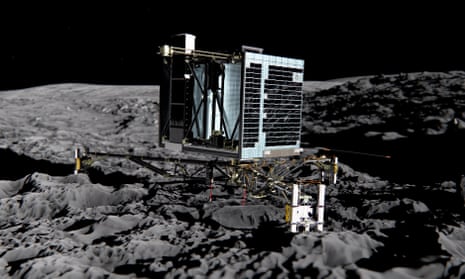The Philae space probe, which electrified the scientific world when it landed on a comet after a 10-year journey, has gone into “eternal hibernation” as ground controllers have given up attempts to re-establish contact with the craft.
Professor Monica Grady, who worked on a shoebox-sized instrument on Philae called Ptolemy that analyses gas and dust, said it was getting too cold on the comet for Philae to “chirrup” and was regretful at its apparent demise, although she was not yet ready to lose all hope. “Never say never,” she said.
Sad to say farewell to @IamPhilaeLander . Maybe get a pic when @ESA_Rosetta lands later in Sept Fingers crossed. @EuroCares @OpenUniversity
— Monica Grady (@MonicaGrady) February 12, 2016
Philae, a dishwasher-sized probe, accomplished an astonishing feat in November 2014, when it landed on the surface of the duck-shaped comet 67P/Churyumov-Gerasimenko after being launched from its orbiting mothership Rosetta. The comet was travelling at up to 84,000mph and more than 300 million miles away from Earth. Philae’s landing was famously rocky: it bounced several times before landing, on its side, in the shade.
With its solar panels in shadow, the probe was operational for just 60 hours before its batteries died and it was placed into hibernation. It resumed contact with the European Space Agency in June last year. Scientists last made contact with the lander on 9 July, but efforts since then have failed and ground controllers have all but given up.
The German Aerospace Center (DLR), which led the consortium behind Philae, said it is probably now covered in dust and too cold to function.
“Unfortunately, the probability of Philae re-establishing contact with our team at the DLR Lander Control Center is almost zero, and we will no longer be sending any commands,” Stephan Ulamec, the lander’s project manager at DLR, told the BBC.
Before it stopped communicating, Philae sent back reams of data about 67P/Churyumov-Gerasimenko that scientists will spend years analysing.
Grady, whose ecstatic reaction to the landing went viral on social media, said Ptolemy had sent back enough information on molecules for her science team at the Open University to study for at least two to three years.
“There is so much data to interpret and tons of stuff to work on,” said Grady, a key member of the Rosetta science team at the Open University. “There was lots of carbon dioxide, water and more complicated molecules.”
Grady said Philae’s imperfect landing was ironic, as in the shade it managed to last longer than it would have had it landed properly and exposed to the sun; its electronics would have “frazzled” relatively quickly as the comet approached the sun. The flipside, however, was that because Philae rested on its side, Ptolemy could not drill and retrieve ice from the comet’s surface, which would have allowed her team to learn more about water on the comet.
Nevertheless, Grady declared Philae a massive success, having achieved practically all its scientific goals in November 2014.
“No other space agency had attempted to do this - landing a small body on another small body and it was ancient technology that had been built 15 years before it landed,” she said.
Rosetta, however, will continue to carry out scientific measurements in orbit around comet 67P until September, when it will be steered to land on the surface as well.

Comments (…)
Sign in or create your Guardian account to join the discussion